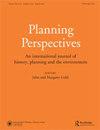Bioregional urbanism: reflecting on the legacy of the RPAA through the lens of Jaqueline Tyrwhitt
IF 0.9
3区 历史学
0 ARCHITECTURE
引用次数: 0
Abstract
ABSTRACT The Regional Planning Association of America (RPAA) was formed in 1923 to promote urban development based on the English Garden City ideal linked to the regionalism of Patrick Geddes. But Lewis Mumford, the RPAA’s principal spokesperson, incorporated his version of Geddes’ ideas in the RPAA’s agenda. Arguably the RPAA/Mumford’s vision of garden cities as a remedy for the problems of the sprawling metropolis incorrectly became identified with Geddes. This essay presents a more nuanced perspective by examining the RPAA and efforts to relaunch it, starting in the late 1930s, through the lens of Jaqueline Tyrwhitt, who was largely responsible for the revival of interest in Geddes’s ideas after World War Two. The paper traces the development of Tyrwhitt’s ideas as she introduces Geddes in his own words to a new generation, thus dispelling previous misconceptions, and formed an influential synthesis of Geddes’ bioregionalism and modernist urbanism that framed debates on post-war reconstruction. She put forward the urban constellation – a further development of Geddes’ concept of the conurbation – explicitly as an alternative to the relaunched RPAA’s call for decentralization, now as strategy for civil defense.生物地域性城市主义:通过杰奎琳·Tyrwhitt的镜头反思RPAA的遗产
美国区域规划协会(RPAA)成立于1923年,以帕特里克·格迪斯的地方主义思想为基础,以英国花园城市为理念,促进城市发展。但RPAA的首席发言人刘易斯·芒福德(Lewis Mumford)将他对格迪斯观点的看法纳入了RPAA的议程。可以说,RPAA/Mumford的花园城市愿景是对无序扩张的大都市问题的补救措施,错误地与Geddes等同起来。本文通过杰奎琳·蒂尔维特(jacqueline Tyrwhitt)的视角,从20世纪30年代末开始审视RPAA和重新启动它的努力,呈现了一个更细致入微的视角。蒂尔维特在二战后对格迪斯的思想重新产生兴趣,在很大程度上要负责任。这篇论文追溯了Tyrwhitt思想的发展,她用格迪斯自己的话向新一代介绍了格迪斯,从而消除了之前的误解,并形成了一个有影响力的综合格迪斯的生物地域主义和现代主义城市主义,为战后重建的辩论提供了框架。她提出了城市星座——这是Geddes的城市概念的进一步发展——明确地作为重新启动的RPAA对权力下放的呼吁的替代方案,现在作为民防战略。
本文章由计算机程序翻译,如有差异,请以英文原文为准。
求助全文
约1分钟内获得全文
求助全文
来源期刊

Planning Perspectives
Multiple-
CiteScore
1.50
自引率
12.50%
发文量
85
期刊介绍:
Planning Perspectives is a peer-reviewed international journal of history, planning and the environment, publishing historical and prospective articles on many aspects of plan making and implementation. Subjects covered link the interest of those working in economic, social and political history, historical geography and historical sociology with those in the applied fields of public health, housing construction, architecture and town planning. The Journal has a substantial book review section, covering UK, North American and European literature.
 求助内容:
求助内容: 应助结果提醒方式:
应助结果提醒方式:


